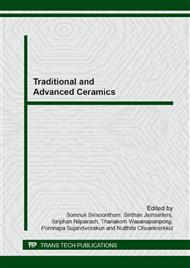[1]
X. Su, H. Zhao, F. Xiao, J. Jian and J. Wang, Synthesis of flower-like 3D ZnO microstructures and their size-dependent ethanol sensing properties, Ceram. Int. 38 (2012) 1643-1647.
DOI: 10.1016/j.ceramint.2011.09.055
Google Scholar
[2]
A. Moezzi, A. M. McDonagh and M. B. Cortie, Zinc oxide particles: Synthesis, properties and applications, Chem. Eng. J. 185–186 (2012) 1-22.
DOI: 10.1016/j.cej.2012.01.076
Google Scholar
[3]
F. Xu, et al., Long Electron−Hole Separation of ZnO-CdS Core−Shell Quantum Dots, J. Phys. Chem. C. 113 (2009) 19419-19423.
DOI: 10.1021/jp903813h
Google Scholar
[4]
J. Nayak, H. Lohani and T. K. Bera, Observation of catalytic properties of CdS–ZnO composite nanorods synthesized by aqueous chemical growth technique, Current Applied Physics. 11 (2011) 93-97.
DOI: 10.1016/j.cap.2010.06.025
Google Scholar
[5]
A. Yu, et al., Micro-lotus constructed by Fe-doped ZnO hierarchically porous nanosheets: Preparation, characterization and gas sensing property, Sensors and Actuators B: Chemical. 158 (2011) 9-16.
DOI: 10.1016/j.snb.2011.03.052
Google Scholar
[6]
X. Yan, T. Itoh, S. Dai, Y. Ozaki and Y. Fang, Cu, Mn doping effect to optical behavior and electronic structure of ZnO ceramic, J. Phys. Chem. Solids. 74 (2013) 1127-1130.
DOI: 10.1016/j.jpcs.2013.03.011
Google Scholar
[7]
A. Hameed, M. A. Gondal and Z. H. Yamani, Effect of transition metal doping on photocatalytic activity of WO3 for water splitting under laser illumination: role of 3d-orbitals, Catal. Commun. 5 (2004) 715-719.
DOI: 10.1016/j.catcom.2004.09.002
Google Scholar
[8]
H. Diker, C. Varlikli, K. Mizrak and A. Dana, Characterizations and photocatalytic activity comparisons of N-doped nc-TiO2 depending on synthetic conditions and structural differences of amine sources, Energy. 36 (2011) 1243-1254.
DOI: 10.1016/j.energy.2010.11.020
Google Scholar
[9]
H. X. Sang, X. T. Wang, C. C. Fan and F. Wang, Enhanced photocatalytic H2 production from glycerol solution over ZnO/ZnS core/shell nanorods prepared by a low temperature route, Int. J. Hydrogen Energy. 37 (2012) 1348-1355.
DOI: 10.1016/j.ijhydene.2011.09.129
Google Scholar
[10]
Z. Wu, et al., Forming water-soluble CdSe/ZnS QDs using amphiphilic polymers, stearyl methacrylate/methylacrylate copolymers with different hydrophobic moiety ratios and their optical properties and stability, Colloids Surf A Physicochem Eng Asp. 350 (2009).
DOI: 10.1016/j.colsurfa.2009.09.014
Google Scholar
[11]
S. Yan, et al., Solution-based synthesis of ZnO nanoparticle/CdS nanowire heterostructure, J. Alloys Compd. 509 (2011) L239-L243.
DOI: 10.1016/j.jallcom.2011.04.016
Google Scholar
[12]
B. Li and Y. Wang, Synthesis, microstructure, and photocatalysis of ZnO/CdS nano-heterostructure, J. Phys. Chem. Solids. 72 (2011) 1165-1169.
DOI: 10.1016/j.jpcs.2011.07.010
Google Scholar
[13]
T. Bora, H. H. Kyaw and J. Dutta, Zinc oxide–zinc stannate core–shell nanorod arrays for CdS quantum dot sensitized solar cells, Electrochim. Acta. 68 (2012) 141-145.
DOI: 10.1016/j.electacta.2012.02.036
Google Scholar
[14]
S. Yan, et al., Synthesis of uniform CdS nanowires in high yield and its single nanowire electrical property, J. Solid State Chem. 182 (2009) 2941-2945.
DOI: 10.1016/j.jssc.2009.07.016
Google Scholar
[15]
S. Yamada, A. Y. Nosaka and Y. Nosaka, Fabrication of CdS photoelectrodes coated with titania nanosheets for water splitting with visible light, J. Electroanal. Chem. 585 (2005) 105-112.
DOI: 10.1016/j.jelechem.2005.07.025
Google Scholar
[16]
V. Singh, P. K. Sharma and P. Chauhan, Synthesis of CdS nanoparticles with enhanced optical properties, Mater. Charact. 62 (2011) 43-52.
Google Scholar
[17]
P. Nandakumar, et al., Synthesis and characterization of CdS nanocrystals in a perfluorinated ionomer (Nafion), Mater. Sci. Eng., B. 83 (2001) 61-65.
Google Scholar


